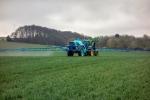Horizon Europe Legume Project: Intercropping of legumes and cereals for sustainable agriculture throughout Europe
- Type Project
- Status Signed
- Execution 2022 -2026
- Assigned Budget 7.188.013,5 €
- Scope Europeo
- Main source of financing Horizon Europe 2021-2027
- Project website Proyecto LEGUMINOSE
Growing two or more crops in close proximity allows for greater yields on a given plot. This intercropping practice is also more sustainable than traditional cropping systems. For example, intercropping promotes biodiversity, optimizes land use, and optimizes biogeochemical cycles in agroecosystems.
However, it is not yet widely accepted among European farmers. The EU-funded LEGUMINOSE project will identify barriers to intercropping and promote awareness and acceptance among farmers, providing knowledge and demonstrations that promote the economic, environmental, and social benefits of legume-cereal intercropping. To overcome barriers to intercropping implementation, the project will establish a network of six field trials and agricultural laboratories across Europe, Egypt, and Pakistan.
As conventional cropping systems face deteriorating soil quality, biodiversity loss, and declining ecosystem services, there is an urgent need to shift practices toward more sustainable yet productive systems. Intercropping enhances biodiversity, maximizes land productivity, and optimizes biogeochemical cycles in agroecosystems, but lacks acceptance among European farmers. Legume-based intercropping leverages biological diversity and synergistic effects between partner plants while reducing external inputs.
A major objective of LEGUMINOSE is to identify barriers to intercropping and improve farmer acceptance by providing knowledge and demonstrations that promote the economic, environmental, and social benefits of legume-cereal intercropping. LEGUMINOSE will evaluate the potential for intercropping by focusing on pesticide reduction, plant microbial-mediated element cycling, improved soil health, and crop quality and health. To overcome barriers to intercropping implementation, we will establish a network of six field trials and farm laboratories (20 farms in each country; 180 on-farm trials) in different pedoclimatic zones in Europe (IT, DE, DR, ES, PL, CZ, UK), Egypt, and Pakistan. In addition, we will integrate remote sensing and crop modeling to survey fields, improve field-scale outcomes, and create a web-based decision support system for intercropping.
In collaboration with various stakeholders, the economic, ecological, and social benefits of legume intercropping systems will be assessed and disseminated internationally, from the farm level to policymakers. We will recognize and engage the entire value chain to explore and test innovative marketing strategies for intercropped products. LEGUMINOSE will contribute to the ecological intensification of European agriculture by providing science-based, farmer-led, and economically viable transformations for legume-based intercropping systems.
- Project website (CORDIS)
- As for crops, two or more are better than one.
- As for crops, two or more are better than one.
- Calling all British farmers interested in intercropping
- Dynamic Partnership Establishment Map
- Report on the transition path and socio-technical blockages in herbaceous agric…
- Report on opportunities for intercropping species mixing
- Report on barriers and opportunities for intercropping
- Intercropping legumes and cereals as a regenerative agriculture strategy that s…







